Menu
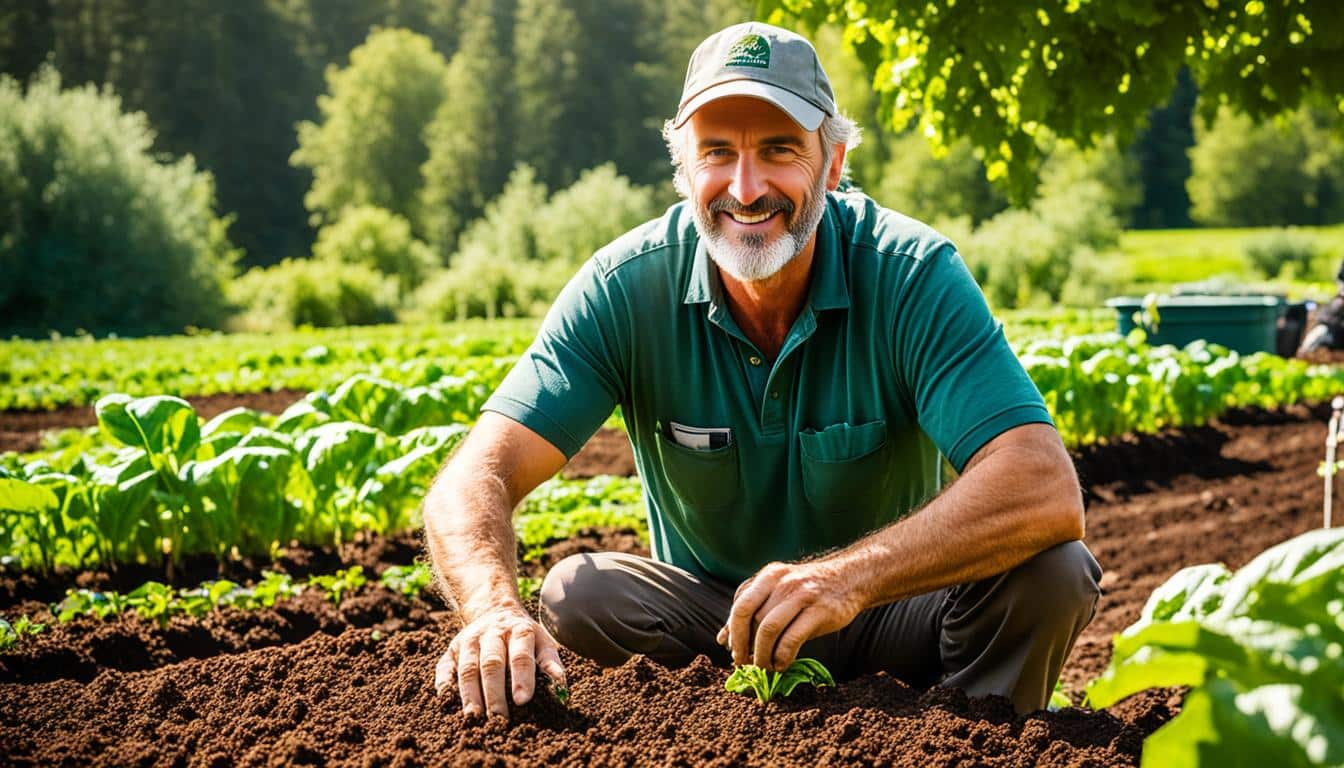
Did you know that fertile soil gives plants crucial nutrients? It also supports many organisms, making it hard for the environment to degrade. Organic farming puts a big focus on healthy soil. But, making soil rich is tricky for organic farmers. The amount of nutrients used and the soil’s fertility can vary a lot.
Organic farmers boost soil fertility mostly using natural things. They use crop rotations, animal and green manures, and cover crops. These methods improve the soil and keep crop yields up by using nutrients wisely. They test the soil and plan how much nutrient to use to avoid overloading the soil. This way, they protect the environment and keep the soil healthy for the long run. For more tips on sustainable farming, check out eOrganic.
Soil fertility is key in organic farming. To boost fertility and keep the planet green, farmers use smart methods. These methods work on the soil’s facts to help crops grow well in a natural way.
Plants need special elements to grow. There are sixteen of them that plants must have. Most of a plant’s weight comes from three of these elements. Other important elements include nitrogen, phosphorus, and minerals like iron and zinc.
Organic farmers improve soil by adding natural things. They use compost and manure. These things are natural but can vary in what they offer. They track all they do to be certified organic.
Crop rotation is also important. It keeps the soil healthy. Farmers follow strict rules when using compost and manure. They make sure it’s safe for their crops and the environment.
Organic animals play a big role too. They must have healthy places to live. They eat good food and help the soil be better. This way, the whole farm takes care of itself to produce food.
By using best practices and natural ways, the soil stays strong. This helps our farms be good for the future. Organic farming is all about balance and caring for the Earth.
| Element | Category | Concentration |
|---|---|---|
| Carbon, Hydrogen, Oxygen | Major Components | 95% of Plant Biomass |
| Nitrogen, Phosphorus, Potassium, Sulfur, Calcium, Magnesium | Macronutrients | >500 micrograms/g plant |
| Iron, Zinc, Manganese, Copper, Boron, Chlorine, Molybdenum | Micronutrients | Trace amounts |
Soil health is key in organic farming for long-term success. It’s about the way soil feels, grows life, and holds nutrients. Organic farmers must know how to make their soil a perfect home for plants.
Physical soil structure is all about how soil feels and supports plants. For plants to be healthy, the soil needs to be just right. Organic farmers make sure plants can find water easily and breathe well. They do this by adding things to the soil and not digging too much.
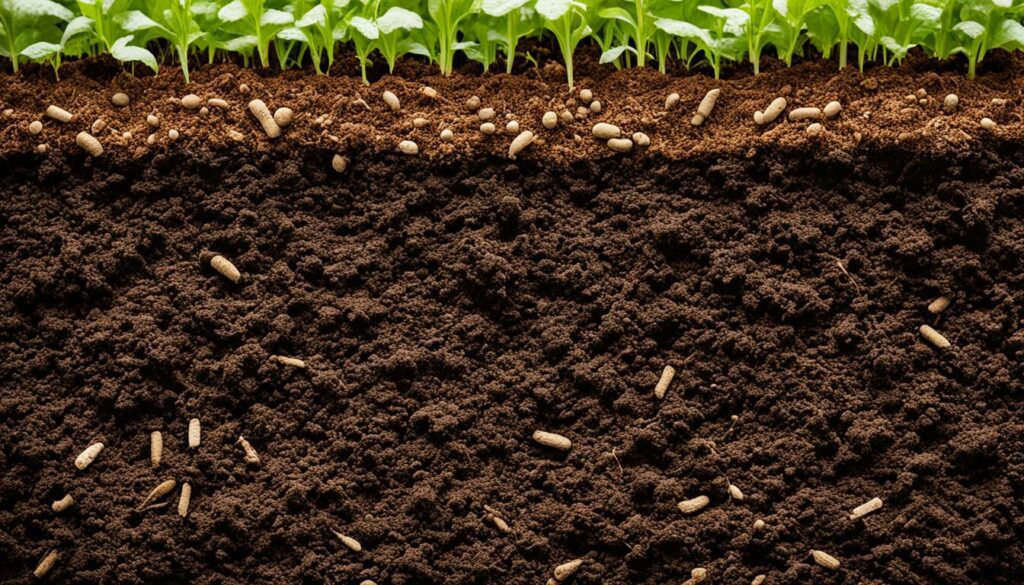
The life in the soil is really important for soil nutrient cycling. Tiny living things turn old plants into food for new ones. Organic farmers help this process by adding natural materials to the soil. A study by Hartmann and others in 2015 showed that this makes the soil full of different helpful microbes.
Making sure the soil has the right chemicals is crucial for plant food. Farmers check the soil’s chemical make-up and add natural fertilisers. They do this to make sure plants get what they need without harming the soil. This approach follows smart advice from experts like Eivazi & Tabatabai (1990).
Putting everything together, organic farming relies on good soil structure, life, and chemistry. This keeps the land strong for growing food year after year. Farmers stay updated on the best ways to care for their soil. This helps ensure a healthy food future for everyone.
Natural soil fertility is key in organic farming. It uses crop rotation and green manures to improve soil health. This method supports sustainable farming and boosts long-term crop productivity.
Crop rotation is vital for healthy soil. It means changing the types of crops grown in one place over time. The benefits of crop rotation include breaking pest and disease cycles. This makes the farm less dependent on chemicals. It also helps improve soil structure and fertility through plant variety and organic material.
Varying crops helps balance soil nutrients. Each crop takes in different nutrients from the soil. For example, legumes add nitrogen back to the soil after they are harvested. This shows how working with nature can boost farm productivity.
Cover crops like clover and rye are key to healthy soil. They protect the soil between main crop seasons, reducing erosion and weeds. They also add essential organic matter to the soil, helping it stay fertile.
Green manures boost soil fertility further. By planting certain crops to later be added back to the soil, farmers can increase nitrogen levels. This process speeds up the growth of helpful soil microbes, vital for healthy soil.
| Practice | Benefits | Key Nutrients Added |
|---|---|---|
| Crop Rotation | Prevents pest build-up, improves soil structure | Nitrogen, Organic Matter |
| Cover Crops | Reduces erosion, suppresses weeds | Organic Matter |
| Green Manures | Increases nutrient content, promotes microbial activity | Nitrogen, Organic Matter |
By using these methods in organic farming, soil fertility grows naturally. This aligns with sustainable farming. With the right mix of crop rotations, cover crops, and green manures, soil becomes strong. It supports healthy and productive crops for years to come.
Looking after soil fertility organically involves many methods. Each method helps in making farming more sustainable. These include organic composting, using animal manure, and bio-dynamic practices. I will discuss each one to show why they are important for organic farming.
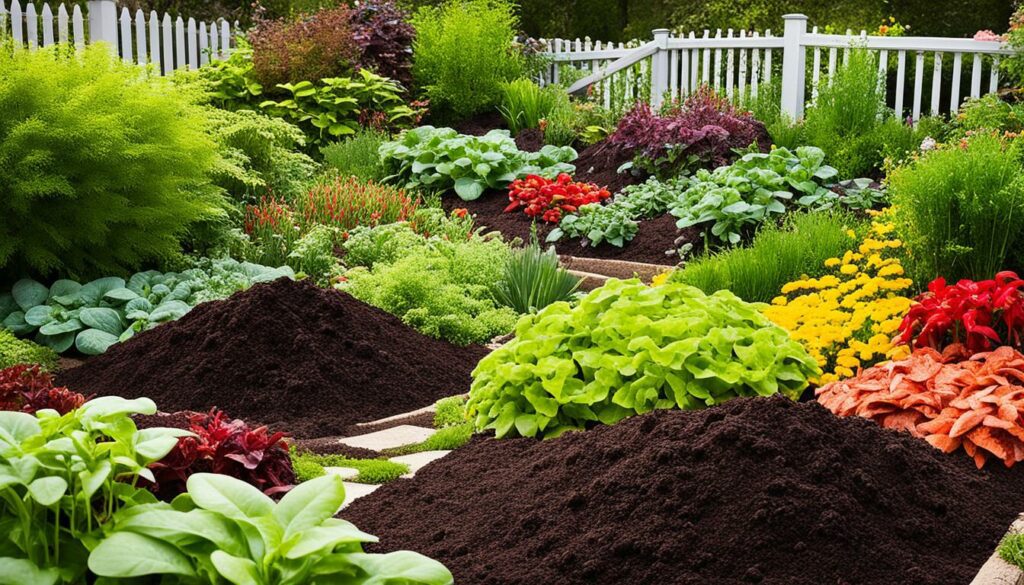
Organic composting is a key part of caring for the soil. It changes waste like plant and food scraps into humus. This material is full of nutrients. It’s great for making the soil better, keeping moisture in, and letting plants get more nutrients. Good composting means using the right amount of carbon and nitrogen. You also need to keep it moist and turn it to get air inside.
Animal manure fertilisation is also vital. It gives plants important nutrients like nitrogen and phosphorus. But it needs to be done right to avoid putting too many nutrients into the soil. Organic farmers use tests, knowledge, and advice to figure out when and how much manure to use. This keeps the nutrients in balance and protects the environment.
Bio-dynamic farming brings a spiritual and holistic view to the soil. It treats the farm as a living, breathing system. It uses special mixtures of fermented manure, minerals, and plants. These are put into compost or directly onto the soil. They make soil more fertile and support life in the soil. This keeps the whole farming system strong and full of life.
| Method | Primary Nutrients | Additional Benefits |
|---|---|---|
| Composting | Carbon, Nitrogen | Improves soil structure, moisture retention |
| Animal Manures | Nitrogen, Phosphorus | Rich in micronutrients, enhances fertility |
| Bio-dynamic Enrichment | Varied (based on specific preparations) | Enhances biological activity, self-sustaining soil system |
To sum up, using these organic methods makes the soil healthier. It not only helps the farm but also the environment. Organic farmers enrich the soil naturally. This makes the soil better, helps plants grow, and supports a healthier planet.
Using natural soil amendments boosts soil fertility in organic farming. These materials help reach goals for keeping carbon levels in check. They also make the soil healthier, especially in places like California. There, capturing carbon is key to farming that lasts.
Alfalfa meal is top-notch for feeding the soil. It brings nitrogen and tiny minerals to the party, which are great for plants. This natural method helps the soil hold water and encourages bugs that boost plant growth. It’s a win-win for making soil better and getting more crops.
Bone meal is key for fixing low phosphorus in the soil. It’s packed with calcium and phosphorus, which are good for roots and flowers. Using bone meal ensures plants get all the nutrients they need. Plus, it works slowly, making the soil better year after year.
Fish emulsion is like a supercharged energy drink for plants. It’s got loads of nitrogen for strong growth and less plant stress. Put it on the leaves of plants, and they get a fast nutrient boost. This helps young plants grow up strong and keeps all plants healthy.
These soil amendments are vital for richer soil and better yields. Adding alfalfa meal, bone meal, and fish emulsion the right way helps us use nutrients well. Plus, it’s good for the planet, supporting farming that stores carbon and keeps soil healthy.
Eco-friendly fertilisers are key in managing nutrients for organic farms. They include manures, composts, green manures, and composted household waste. These help boost soil health and support sustainable farming.
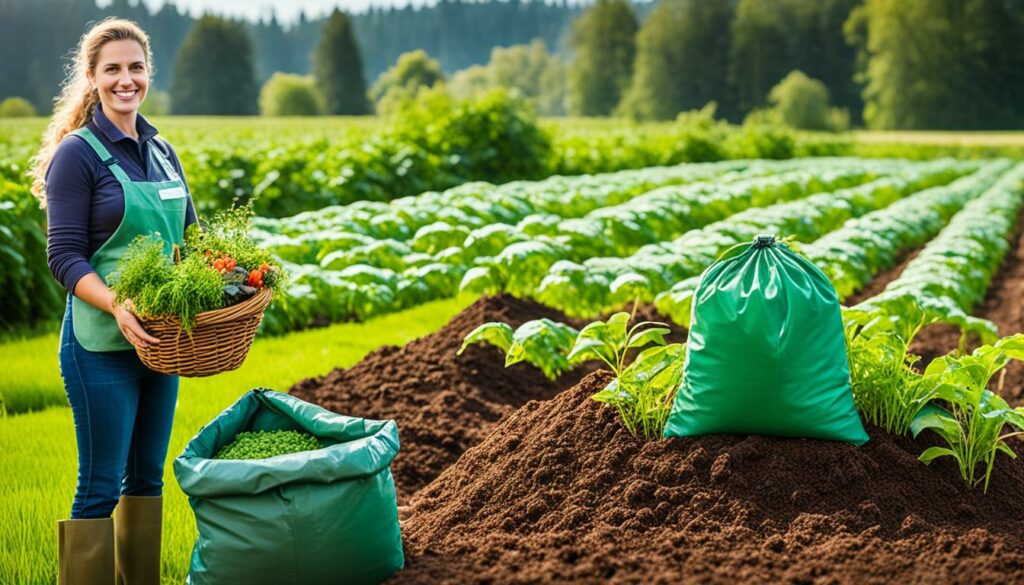
Manures and composts give crops needed nutrients. Manure, from animals, is full of nitrogen, phosphorus, and potassium. These are great for crops in the fall and spring. They also keep giving nutrients to the soil. This helps the soil stay fertile. Household waste can also be turned into compost. This process makes soil better and helps the good bacteria in the soil grow.
In 2016, the European Union used about 690,000 tons of organic fertilisers. This shows how important they are for sustainable farming.
Green manures are cover crops planted to plough back into the soil. They are good because they add nutrients. They also make the soil better and stop too many nutrients from washing away.
These crops help fight weeds and keep the soil from washing away. Growing things like clover or peas can add more nitrogen to the soil. This is a friendlier way to farm.
Turning household waste into compost is a smart way to reuse nutrients. It’s good for the Earth. This method turns trash into something useful for soil. It makes the soil better without making landfills bigger.
Using this compost helps farmers stick to eco-friendly farming. It makes sure their crops have the nutrients they need. And it keeps trash from piling up.
These approaches show how important eco-friendly fertilisers are for good farming. Using manure, compost, green manures, and waste compost together helps the land. It lessens the harm from chemicals and keeps an ecosystem in balance.
Soil health is key in organic farming. It gives nutrients to plants and helps a range of life thrive. Yet, testing soil in organic farming can be hard due to nutrient changes. This makes planning how to use nutrients crucial for good soil health.
To keep soil healthy, farmers use certain methods. They rotate crops, grow green manures, and use cover crops. These activities help make the soil better by adding essential nutrients needed by plants. Elements like carbon, nitrogen, and potassium are crucial for plants, while others like copper and molybdenum are also essential but in smaller amounts.
Organic farming focuses on natural methods for nutrition. This makes the use of organic fertilizers more important. Yet, these fertilizers can cost more than regular ones. They also weigh more and may not be the same throughout. This is why farmers have to be careful when choosing fertilizers and checking that they meet certification standards.
There are many organic fertilizers out there. Each offers different nutrients and works in various ways. For example, some come from food by-products or animal waste, like feather meal or manure. Farmers need to know about these options to pick the best ones for their soil.
It’s also important to understand things like Cation Exchange Capacity (CEC). This and Cation Saturation Ratios (CSR) help maintain the balance of nutrients in soil. When these are right, the soil offers the best conditions for plants to grow well.
For nitrogen, organic farms use compost, organic matter in the soil, and plants that add nitrogen to the soil. But too much nitrogen can cause harm. It can make plants less strong, more prone to diseases, and pollute water.
Getting involved in soil testing and managing nutrients well is key to keeping the soil healthy. It’s how we protect the future of organic farming.
“In organic farming, understanding your soil’s nutrient status through precise soil testing and applying well-crafted nutrient budgeting strategies ensures the harmony and productivity of your farm ecosystem.”
Managing soil nutrients well is crucial. It prevents over-use and keeps farming eco-friendly.
Keeping the right balance of nutrients is key in organic farming to keep the soil fertile and sustain crop growth. In the UK, in 2000/01, organic farming was worth £97 million. About 81% of the organic land was used for grazing and pasture. This shows how important it is to manage nutrients well to keep the soil healthy.
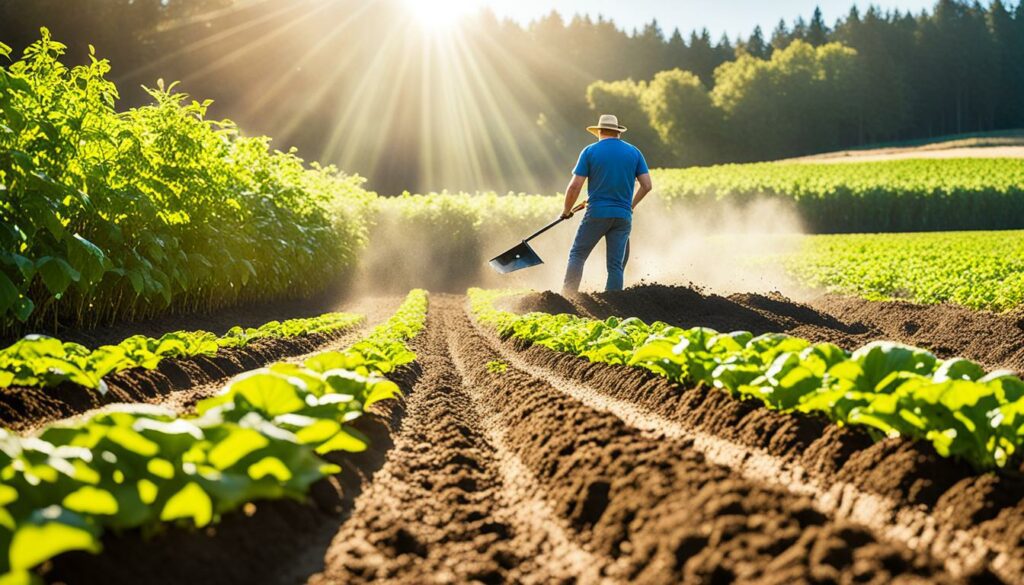
Organic farmers use special methods to keep the soil full of nutrients, especially when they don’t have animals. They rotate crops like peas and beans with other plants to add nitrogen from the air. This helps the soil stay rich and supports the growth of other crops.
In places where a lot of vegetables and fruits are grown organically, it’s even more crucial to maintain soil fertility. They use a careful rotation of crops and add special plants that are turned back into the soil. This makes sure the soil has enough nutrients and helps beneficial microorganisms thrive.
Using too many nutrients can be bad for plants and the environment in organic farming, just like in normal farming. Organic growers must be precise in how they add fertilisers, so they don’t waste or harm the environment. By using organic fertilisers that come from various sources, they decrease the risk of overdoing it.
Some substances, like sodium nitrate from natural sources, can also be used. It’s allowed because it’s not harmful and a little goes a long way. By testing the soil and knowing what each crop needs, farmers can ensure they don’t use too much or too little.
| Organic Production Area | Percentage |
|---|---|
| Rough Grazing and Permanent Pasture | 81% |
| Temporary Ley | 9% |
| Arable Production | 7.5% |
| Horticultural Crops | 2% |
Smart and consistent care is the backbone of organic farming. By using the right mix of farming tactics, growers can protect the future of their land. This way, they maintain its productivity over time.
Regenerative agriculture is all about healing the land. It focuses on making the soil healthy again. This way, the environment becomes better, not just for now, but for the future too.
One main idea in regenerative farming is to disturb the soil as little as possible. Research shows that less ploughing helps the soil stick together better. It also traps more carbon, which is great for soil health. Using cover crops stops the wind from blowing away the soil’s top layer. This keeps the soil rich and able to grow more food.
Having lots of different crops is key in this farming. It keeps plants and food healthier, needing fewer sprays. Rotating crops in fields also means less sickness in plants. That’s about a 73% cut in diseases. This type of farming makes food richer in vitamins and minerals too.
Looking after animals well is also a big part of regenerative farming. Good care of animals helps plants grow better and the soil to get more carbon. This helps the land produce more food and support more kinds of life.
These farming methods are good for everyone. They make more food, which helps farmers make more money. Plus, they make the community better by improving education and saving money.
In the end, regenerative farming is about farming in a way that lasts. It means our food supply and the land are safe for our children. It’s all about making farming work with nature, not against it.
Improving soil health is key to keep agriculture sustainable. More microbe action and better soil form give great benefits. Organic farming plays a big role in keeping the soil working for years.
Soil needs microbes to grow well and recycle nutrients. Organically treated soils have more organic stuff than conventional ones. This attracts helpful microbes, making the land fertile. Techniques like growing legumes with no-till farming help keep the soil rich.
Plants that attract good bugs, like flowers, also make the field and the plants healthier. These bugs, in turn, help the soil. So, it’s like a big, helpful circle.
Adding organic material to the soil makes it better. This rich soil lets water in well, stops it from running off, and helps crops grow. Growing fruits with plants in between maintains this good structure. It fits nicely with how farms usually work.
Keeping the soil healthy is how I run my farm well. It doesn’t just help now but makes sure the land is good for those after us.
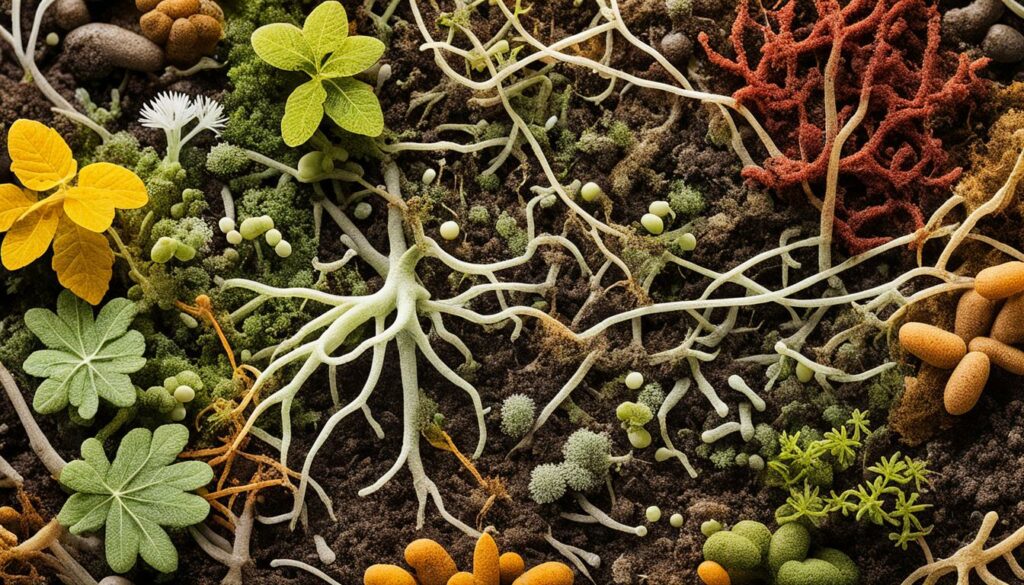
Balancing soil pH in organic farming is key for good soil health. It’s about managing whether the soil is too acidic or too alkaline. Most soils in Montana and Wyoming are close to being just right, with a pH of 6.5 to 8. Getting the pH right helps plants grow better and produce more crops.
Knowing about soil pH helps farmers make their soil less acidic or alkaline. This helps decide when to add things like lime or sulfur to the soil. The right pH level makes it easier for plants to get the nutrients they need from the soil. Different nutrients become available at different pH levels. For example, nitrogen, potassium, and others are best at pH 6.5 to 8. But boron, iron, and others like it a bit lower, at pH 5 to 7.
Looking after soil’s acidity or alkalinity helps with nutrient availability. In some places, soils are getting more acidic over time. Knowing how to adjust the soil pH is crucial for farmers. Too much acidity makes some nutrients harmful to plants. It also makes other important nutrients less available. Aim for a pH of 6.0 to 7.5. This makes sure plants can use most of the nutrients in the soil.
Bio-fertilisers are a natural way to boost plant nutrition and enrich the soil. They come from living sources like microbes. These fertilisers help plants grow better by supporting natural tasks, such as fixing nitrogen and making phosphorus easier for plants to use. This process also involves plant-friendly bacteria and useful microorganisms. They work together to make soil healthier and more fruitful.
Many farmers use too many mineral fertilisers. This can harm the environment and reduce the variety of plant and animal life. In contrast, using bio-fertilisers is a green choice. They provide plants with the right mix of essential nutrients, making the soil better at holding onto water and nutrients. This is great for the environment and for growing healthier crops.
Experts like Kumar and Mahanty have studied the benefits of bio-fertilisers. Their work shows these fertilisers help farming in sustainable ways. For example, special bacteria in the roots of plants have helped crops like corn and soybeans grow better (Batista et al., 2018). This discovery is a step towards making farming more eco-friendly and effective.
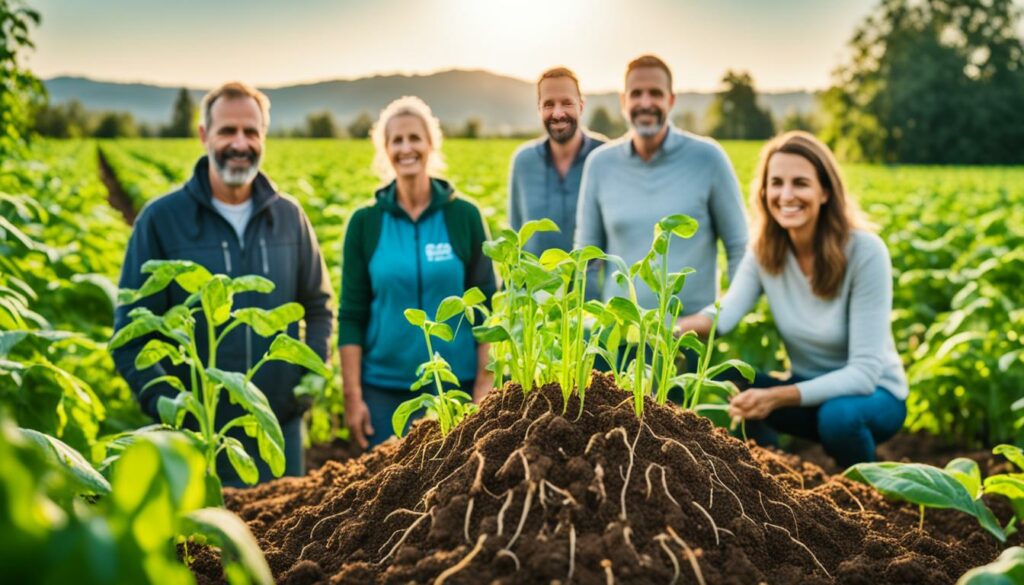
Chlorella vulgaris has been especially useful as a bio-fertiliser. It has improved the birth of plants from seeds, like tomatoes and cucumbers (Bumandalai & Tserennadmid, 2019). Bacteria that can unlock zinc in the soil are another example. They have made wheat plants grow better by increasing their zinc levels (Kamran et al., 2017). These are just a couple of examples proving bio-fertilisers can make soil richer and help plants thrive.
Bio-fertilisers are more than just food for plants. They help the soil work better on its own. This benefits the environment. Using bio-fertilisers is also in line with caring for the land over a long time, instead of just for a season or two. They support healthy soil and steady crop growth, fitting well with the idea of organic farming.
The best organic farming techniques combine key practices to keep soil rich and reduce harm to the environment. These include using cover crops, rotating crops, and tilling less.
Growing cover crops is core to organic farming. They’re not for harvesting but to protect the soil. Crops like clover and rye prevent erosion, stop weeds, and boost the soil’s health. They also add nitrogen to the soil, vital for a strong organic farming system.
Switching crops helps break insect cycles and reduces diseases. It makes the soil more robust over time. Some farmers use long, varied crop rotations to enhance biodiversity and improve soil quality.
Conservation tillage is also key. It means disturbing the soil less, which cuts down on erosion and keeps the soil rich. This method supports healthy soil, retains water, and boosts life in the soil, essential for good farming.
Using all these methods together helps farmers keep their land productive and healthy. By planting cover crops, changing crops, and tilling wisely, they build farming systems that last and protect the environment.
Organic farmers work hard to beat soil fertility problems. They use both natural soil healing and nutrient care methods. It’s crucial for them to know their soil well. This means knowing its physical, chemical, and living features. While nearly all of a plant’s mass comes from carbon, hydrogen, and oxygen, many more elements are key for life.
Nutrients can be divided into two groups. Macronutrients like nitrogen and phosphorus are needed in bigger amounts. On the other hand, micronutrients like iron and zinc are required in smaller quantities. Sandy soils might need more micronutrients to grow crops well.
Organic fertilizers are essential but need to be used in larger amounts. This is because they have fewer nutrients than regular fertilizers. Still, they’re better for the environment. Organic farmers use natural items like alfalfa meal and fish emulsion to enrich the soil.
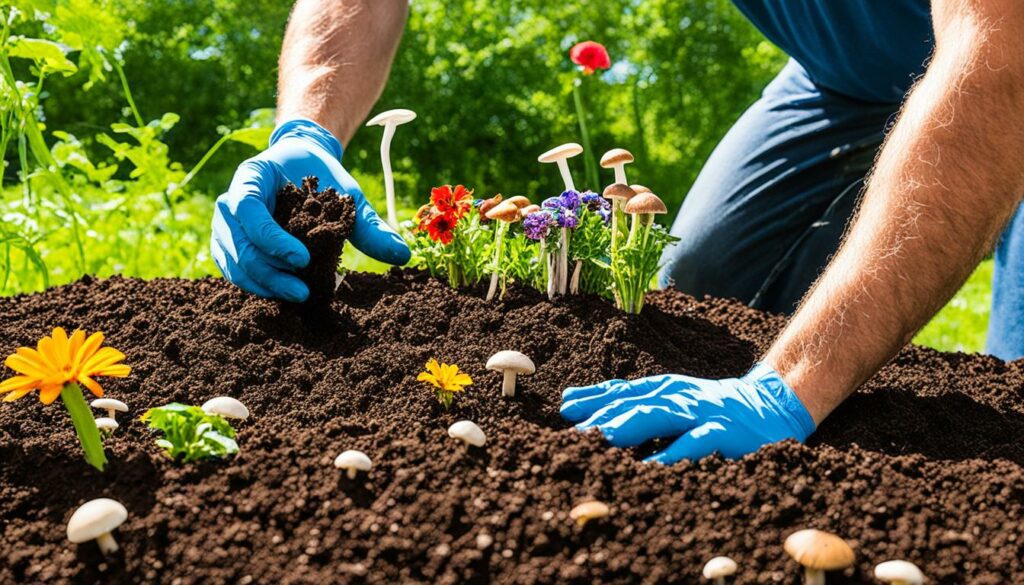
Composts and manures bring a lot of nutrients. Yet, they must be used carefully. For example, manures should be used according to the plant’s phosphorus needs. If crops are for people to eat, there are rules about using animal manure. Following these rules is vital for safe crop production.
| Soil Nutrient Elements | Examples of Organic Amendments |
|---|---|
| Macronutrients (N, P, K, S, Ca, Mg) | Bone meal, Blood meal, Feather meal |
| Micronutrients (Fe, Zn, Mn, Cu, B, Cl, Mo) | Granite dust, Greensand, Alfalfa meal |
| General Soil Improvement | Composted manures, Green manures, Fish emulsion |
Using cover crops and being gentle with soil helps keep it fertile. Cover crops stop erosion, keep the soil moist, and lower pests. Testing the soil is key. It shows how well the microbes are working and the nutrients are moving. This supports smart farming decisions to combat soil problems.
In sum, improving soil with natural methods and nutrient care is vital for organic farmers. This approach helps keep their land healthy and supports their farming for the future.
Organic farming methods have many benefits over a long time. They help the environment and the economy. By using methods focused on sustainable farming and a holistic view, organic practices keep getting better.
One big win for the environment is more biodiversity with organic practices. A study of over 700 papers found that organic farms boost life variety more than non-organic farms. This means more diverse plants and animals can thrive.
Moreover, organic farming also does less harm to water. It has fewer pollutants, as seen in some studies. Things like using organic fertilisers and not ploughing so much help capture carbon. This slows down climate change and makes the soil healthier.
Organic farming also makes good economic sense. It cuts down on buying expensive chemicals, so it’s cheaper in the long term. Plus, as people want more organic food, farmers can charge more for it. This boosts their income.
Additionally, organic farms are less affected by ups and downs in the market or the weather. This means farmers can more depend on a steady income.
Studies show that going organic is good for the land and the wallet. Research indicates that the health of the soil and the way nutrients move are linked. This is good news for keeping crops steady and the farm earning money.
| Benefits | Organic Farming | Conventional Farming |
|---|---|---|
| Pollution Reduction | Significant | Moderate |
| Soil Health | Improved | Variable |
| Biodiversity | High | Lower |
| Market Value | Premium | Standard |
| Resilience | High | Moderate |
Studies from Hobbs, Sayre, & Gupta in 2008 stress how important conserving the land is for farming’s future. This combination of practices supports a healthier environment and a more secure economy. It’s a smart choice for tomorrow.
Looking back at the journey of organic farming, it’s clear that it’s a sustainable route for agriculture. These methods focus on keeping soil fertility high using natural ways. It’s crucial as the world faces big environmental issues.
When we turn grasslands and forests into farms, we often lose some soil’s organic carbon. To fight this, we should use methods that preserve this carbon. For example, not turning the soil often and using cover crops to keep the soil healthy.
In farming with fewer added materials, production drops if the soil and nutrients lessen. Old ways of farming, like ploughing hard, make the soil’s good parts break down fast. Yet, if we grow cover crops and leave parts of previous crops, the soil gets better. This boosts its health and makes growing food more successful.
Adding carbon to the soil, especially in places that rely on rain, helps a lot. It makes the soil better at soaking up water. This is key for having healthy and productive farmlands.
Good organic farming means making sure the soil’s physical state is good. It also ensures the soil can deal with issues and support life well. Methods like growing different crops in order and using the right soil work promote a healthy living soil. This way, farming can be strong for the future, making sure we have enough food and a balanced environment.
Key practices for better soil include rotating crops. Also, adding natural soil enhancers, composting, and using cover crops. These methods help keep nutrients balanced and the soil full of life.
Organic soil management aims to keep soil healthy for a long time. It uses natural things like compost and animal manure. In contrast, conventional ways use chemicals for quick fixes.
Soil health is key in organic farming. It covers everything plants need to grow well. This includes how the soil feels, what’s in it, and how it feeds plants.
Crop rotation stops pests, makes soil better, and lowers the need for chemicals. It also makes sure the soil gets a mix of good stuff from plants.
Cover crops and green manures feed the soil, fight weeds, and stop soil from washing away. This keeps the soil rich and good for growing food.
Effective techniques are using compost, animal manures, and special enrichments. They all aim to make the soil full of life. This makes a great environment for plants to grow.
Natural amendments like alfalfa and fish emulsion give plants what they need. They make the soil better without harmful chemicals. But, they must be used in a smart way.
Eco-friendly fertilisers come from nature and add goodness to the soil. This way, they help keep the soil fertile for growing food. They also help the soil support life better.
Soil testing and nutrient plans are key. They help know what the soil and plants need. As a result, they help farm without hurting the environment. This leads to healthier food for all.
Avoid giving too many nutrients by thinking and planning carefully. It’s about giving only what the plants really need. This keeps the soil and plants in balance.
Regenerative farming is about making the earth and plants healthy. This is done by growing different crops, disturbing the soil less, and focusing on plants that last a long time. It makes farming work with nature.
Improving soil health helps soil life work better. This makes plants stronger and the farm more successful. It avoids using too much water or nutrients. It keeps the farm going for many years.
Managing pH means keeping the soil’s acidity right. This is done by knowing the soil’s pH. And, by adding things like lime or sulfur to make the soil perfect for plants.
Bio-fertilisers help the soil take care of itself. They work with nature to make the soil and plants healthy. This keeps farms healthy without using chemicals.
The top techniques include cover crops, changing crops regularly, and not ploughing too much. These help the soil stay rich and full of life.
To overcome soil problems, use natural ways. This means adding compost, green manures, and following good crop plans. This is based on checking the soil and getting advice.
The good things about organic farming last for a long time. They help the environment, save wildlife, and make the farm and food better. They also help farmers in the long run, by making their products more valuable.